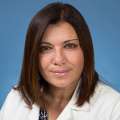When she was a young girl, Maie St. John, MD (RES ’05, FEL ’06), PhD, spent summer days with family in Egypt, a unique experience that would shape her future. On those visits, the future Dr. St. John was immersed in the world of medicine, under the guidance of her grandfather.
“My mom grew up in a small town about an hour-and-a-half east of Cairo, and my grandpa was the town doctor,” says Dr. St. John, who was born and raised in Madison, Wisconsin. “It was an area with lush farmlands along the Nile, and there weren’t big hospitals. My grandfather would be called to people’s homes to try to help them and would receive a home-cooked meal or hospitality in return.”
Like an acorn that falls from the tree, Dr. St. John didn’t land far from her grandfather — a man she describes as a towering figure with a kind heart. The time she spent with him left a lasting impression. He was a physician who didn’t just treat his patients, but also empathized with them. His compassionate care and practice of kneeling to meet his patients at eye level influenced her future career.
One day, when she was just 3 or 4 years old, she accompanied him as he visited a cancer patient, and that moment marked the beginning of Dr. St. John’s career journey that has led to her role today as chair of the Department of Head & Neck Surgery and director of the Office of Cancer Training and Education in the UCLA Health Jonsson Comprehensive Cancer Center.
“There was a young woman who had a very large growth that had disfigured her face,” she recalls. “When I asked my grandfather what it was, he told me it was cancer. I had no idea what that meant, but I knew at that moment that, more than anything, I wanted to work toward finding a cure for cancer in my lifetime.”
That visceral feeling ignited what she describes as her calling in medicine today. “I often tell people I’m living the dream,” Dr. St. John says. “There is nothing more rewarding than to be able to do something selflessly to improve life for another human being.”
She becomes reflective as she shares other pivotal moments throughout her life that have contributed to her pursuit of medicine and success as a surgeon. After receiving her BS from Stanford, she earned her MD and PhD degrees from Yale University School of Medicine. “One of my mentors said to me, ‘You know, Maie, you might want to check into head and neck surgery,’” she recalls. “I was absolutely taken by the beauty of the anatomy. This is the anatomy that underlies how people smile, what defines who they are, their face, their personality. These are nerves that allow them to kiss their children goodnight.”
Like her grandfather, Dr. St. John is committed to seeing the people she treats as more than just patients. She prioritizes seeing them as individuals, with their own unique experiences, fears and hopes for a healthier future. One patient in particular stands out. She was a 32-year-old mother with tongue cancer, and as Dr. St. John prepared for the surgery, “the question weighed heavily on me, how much of her tongue am I going to have to take? It is a question so many of my patients ask.” Then, “as I was backing out of my driveway in my hurry to get to the hospital that morning, I started to hear my car go beep, beep, beep, because I was getting close to the hedges.”
It was a revelatory moment. “It dawned on me in that moment that my car has a sensor that allows me to know how far I am from other objects — from trees or other cars. Why can’t we build a tool like that, one that would allow me to see cancer at the cellular level in the operating room and ‘beep’ when I am at the margin?” she recalls. With such a tool, “I can tell the patient when she wakes up that I precisely resected the tumor, and that I saved everything down to the last cell that I could.”
That inspiration led to the development, in collaboration with colleagues in the UCLA Samueli School of Engineering, of the “dynamic optical contrast imaging system,” a machine being used in UCLA Health operating rooms today that delineates the border between malignant and healthy tissue, enabling surgeons to resect tumors more precisely. Thus far, the device has been used to drive precision surgery for more than 150 patients.
But Dr. St. John’s pursuit of new technologies and techniques to benefit patients is not over. “For the future, I envision an object the size of the current knife that I use in the operating room that can cut around the tumor and allow me to see where the tumor ends and, therefore, enable me to resect the tumor precisely.” Such a device, she says, can be shared with surgeons around the world, “and no matter which part of the body they’re operating on, they can preserve as much function as possible.”
Considering aspiring physicians today, she wants doctors early in their careers to remember, as she does, what it was that drove them to medicine. “Hold on to that humanity,” she says. “Hold on to that integrity and that personal connection. That is the essence of medicine: giving of your mind and heart selflessly to help others.”
Vanessa Villafuerte is a senior public information officer for UCLA Health. Before coming to UCLA Health, she was a broadcast journalist.

